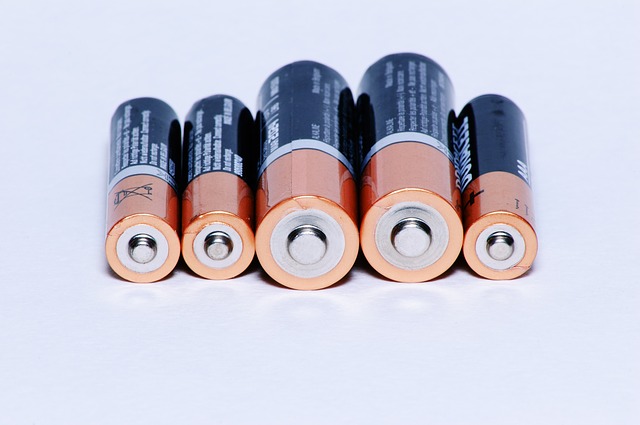
A battery is the easiest solution to provide a voltage source to an electric circuit. Alternative methods include AC adapters (to plug into a wall outlet) and solar cells (that capture sunlight and turn it into voltage). Nevertheless, batteries are by far the most practical solution to power most electronic circuits.
Batteries work by converting chemical energy into electrical energy, and therefore supplying the voltage that makes current flow.
A battery consists of two metal plates immersed in a special solution known as an electrolyte. The reaction between the metal plates and the electrolyte solution generates a flow of charges that accumulate on the negative plate, known as the anode. This depletes the positive plate, called the cathode, of charges. The consequence is the formation of a voltage between the anode and the cathode.
The two metal plates are connected to external prongs or terminations to which you can connect your circuit to power it.
There are many types of batteries. Nevertheless, when it comes to electronic circuits, you only need to consider a few standard battery types, widely available across the country.
Cylindrical batteries are the most common type. Available in four standard sizes (AAA, AA, C and D), they all provide 1.5V. The difference between them is that larger types provide more current than smaller ones.
All cylindrical batteries feature a metal bump on one end. This is always the cathode or the positive terminal. The flat end is the negative terminal or the anode.
Rectangular batteries are also quite common. They supply a voltage of 9V and they consist of six 1.5V tiny cells, combined together in a common encasing to provide the previously mentioned voltage.
Here are a few considerations you may want to know about batteries:
- Besides the above-mentioned battery types, there are special batteries designed to power various devices such as laptop computers, digital cameras, kitchen scales, hearing aids, etc.
- All batteries contain potentially harmful chemicals. As they are toxic to humans and to the environment, you should always handle them with care and dispose of them properly, in accordance with your local laws. Used batteries don’t belong in your garbage bin.
- If you want to measure the voltage output of a battery, you can use a multimeter, set to the proper D voltage range. Connect the black test lead to the anode and the red test lead to the cathode of the battery and you’re done.
- There are also rechargeable batteries available on the market. Even though they are more expensive, rechargeable batteries can help you save money in the long run, as they have a much longer useful life than non-rechargeable batteries. You can recharge them multiple times until they go flat for good. It may interest you to see external maintenance bypass switch.
- For your convenience, consider using a battery holder to connect the batteries to your electronic circuit. Battery holders are basic and fairly inexpensive plastic cases designed to hold one or more batteries.
- Have you ever wondered why you can buy AAA, AA, C and D batteries but not A or B ones? In fact, A cell and B cell batteries do exist, but they never took off.